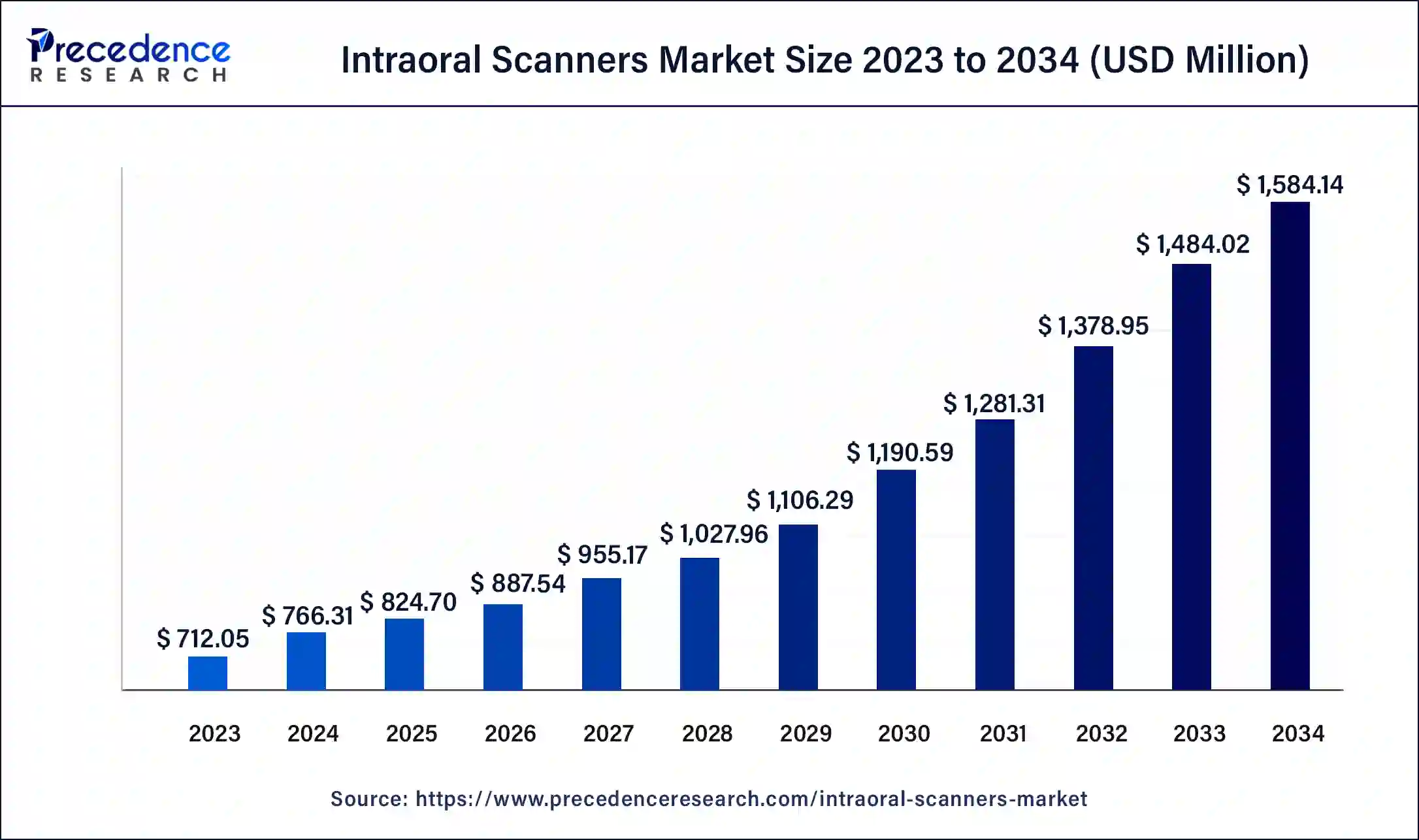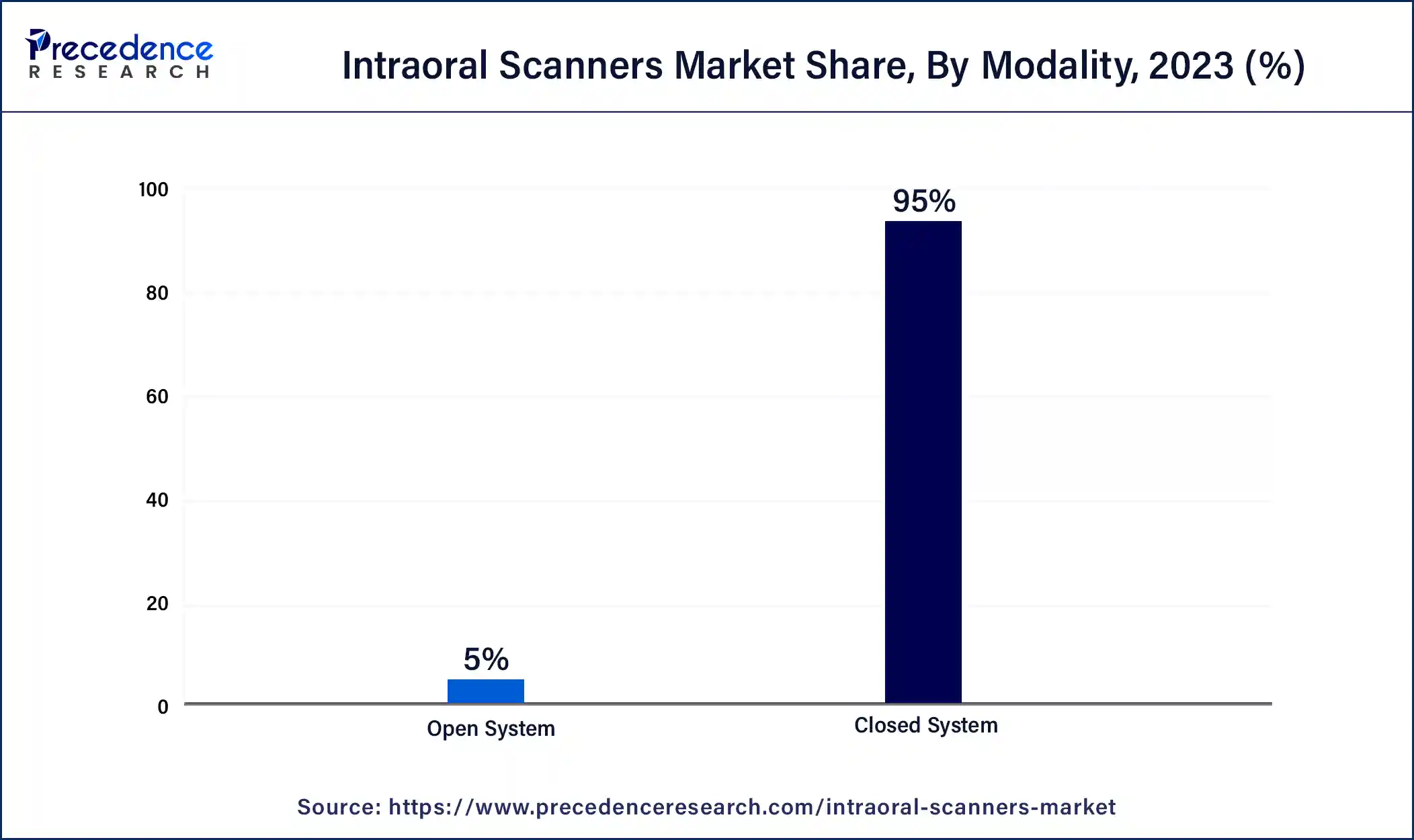August 2024
The global intraoral scanners market size was USD 712.05 million in 2023, estimated at USD 766.31 million in 2024 and is anticipated to reach around USD 1584.14 million by 2034, expanding at a CAGR of 7.53% from 2024 to 2034.
The global intraoral scanners market size accounted for USD 766.31 million in 2024 and is predicted to reach around USD 1584.14 million by 2034, growing at a CAGR of 7.53% from 2024 to 2034. Primary reasons behind the growth of this market are a development in dental diagnosis technology, and rising tooth problems in a large population. This generates a need to develop better solutions for faster and more efficient ways to handle dental diagnostics.

Dentistry is a developing field today because a large number of people are facing issues with their oral health, and there is an increased focus on oral hygiene. Several technological advancements have improved diagnostics and medical care. One such technological advancement in digital dentistry is the intraoral scanners. In traditional dentistry, mirrors were used to check the interior of a patient’s mouth. However, a patient could not get any idea about his/her oral issues, and hence, intraoral scanners were invented so that the patient could get a view of his/her mouth.
Intraoral scanners are primarily used to scan the interior of a patient’s mouth. However, there are also several advanced procedures that can be practiced because of intraoral scanning. Using the scanner and other software, crowns and bridges, implants, and 3D-printed dentures can be made. This is done with high precision, accuracy, and efficiency. Light is projected on the area that is to be diagnosed, and multiple images of the area are captured using the imaging sensors in the scanners. The images are then processed by scanning software, and a 3D surface model of the teeth and gums is produced.
| Report Coverage | Details |
| Growth Rate from 2024 to 2034 | CAGR of 7.53% |
| Intraoral Scanners Market Size in 2023 | USD 712.05 Million |
| Intraoral Scanners Market Size in 2024 | USD 766.31 Million |
| Intraoral Scanners Market Size by 2034 | USD 1584.14 Million |
| Largest Market | North America |
| Base Year | 2023 |
| Forecast Period | 2024 to 2034 |
| Segments Covered | Product Type, Modality, End-user, and Region |
| Regions Covered | North America, Europe, Asia-Pacific, Latin America, and Middle East & Africa |
Building trust
The biggest benefit offered by the intraoral scanners market is that they help the patient to get a view of the oral issues he is facing, and the doctors, too, can explain it properly and easily to the patient by referring to detailed images of teeth, gums, or ulcers. This helps in building trust between the patient and the doctor. Intraoral scanners are less costly than the analog method of obtaining images and are efficient at the same time.
Time-saving and worth the investment
Improvements in the intraoral scanners market have significantly reduced the time required for a dental impression. Diagnosis and treatment take a lot of time using traditional methods. Because intraoral scanners are time-saving, more patients can be covered in a lesser time span, which also reduces dentists' workload. Thus, benefiting the growth of the market.
Enhanced comfort
In the intraoral scanners market, patients seek a comfortable mode of treatment. Dentists can use these devices to provide a comfortable treatment, which is highly effective as well. This also means that patients don’t have to hold unpleasant materials in their mouths and get an unpleasant experience like in traditional dentistry. Due to such comfort, more patients are getting themselves diagnosed readily.
High costs and limited acceptance
The intraoral scanners market can be expensive. They are not widely accepted by many laboratories. This is because of costly maintenance, and hence, many dentists don’t prefer to make this investment. The staff, too, has to be trained appropriately before handling the costly equipment.
The doctors having the facility of intraoral scanners charge high fees for checkups. Many doctors cannot install such expensive devices in areas where not many people are aware of oral health, for example, rural or remote areas. This will further lead to an inconvenience to the people living in rural areas who are aware of their dental health but cannot get good treatment. This is the biggest restraint in the intraoral scanners market.
Efficient dental care
The dental care market can benefit greatly from the development of intraoral scanner technology. Dental care can be made more affordable by making intraoral scanners’ manufacturing costs less so that they are affordable and worth the investment for doctors. The government can allot more funds and provide intraoral scanners to government hospitals. With the help of more awareness campaigns, there will be a boost in the sales of intraoral scanners. The intraoral scanners market provides a more efficient way of diagnosing and providing an experience that is not painful for the patients.
The intraoral scanners segment dominated the market in 2023. Within the intraoral scanner segment, the standalone CAD/CAM scanners, then benchtop intraoral scanners, and 3D handheld scanners are the three main sub-segments responsible for the exponential growth of the segment in the last few years.
Standalone scanners can operate independently, and don’t need to directly integrate with any external software. They have all the necessary software built. The processes like image capturing, processing, or visualizing can be done by the scanner itself. These scanners don’t need to integrate with other systems and can work autonomously. They are user-friendly and can be handled with a little bit of learning.
Benchtop scanners can be placed on the table for scanning purposes. This provides stability in the scanning process. The position of these scanners can be fixed, and a consistent distance can be maintained between the patient and the scanner. High-quality images can be produced using a benchtop intraoral scanner. Benchtop scanners offer high precision and accuracy as well.
3D handheld scanners are portable and can capture detailed images of the patient’s oral cavity. Being portable, they can be easy to use, and doctors can take them along when going for checkup rounds. It is easy for doctors to maneuver these scanners inside the patient’s mouth. One can get feedback in real-time after scanning through the 3D scanners. The images produced using these scanners are detailed and of a high resolution.
The open systems segment dominated the intraoral scanners market in 2023. Open-system intraoral scanners can be integrated with the components that have been manufactured by a third-party vendor. Open-system intraoral scanners can offer more choices, and there is a broad range of brands that one can choose from. There is a relaxation to choosing from multiple pieces of equipment, as an open system shows a broader level of compatibility. In an open system, there are more options to choose the partners.
For instance, if a doctor is working in partnership with a lab and they are trusted partners. However, if one of them decides to change the system, the other partner will have to acquire the same system if it is a closed system. However, this is not an issue with an open system.

The closed system segment is expected to be the fastest-growing segment during the forecast period. Closed intraoral scanners cannot be integrated with components manufactured by any other company, and these systems are proprietary. Closed systems have limited flexibility. End users have limited options to choose from. Although there are limitations in a closed system, closed-system intraoral scanners can assure higher quality standards because sometimes a third-party component system might not perform optimally.
The dental clinic's segment dominated the intraoral scanners market in 2023. Dental clinics are efficient in providing dental care. There are various pieces of equipment for dental surgery, cleaning, implants, etc. One can get the teeth examined, cleaned, filled, or get other necessary dental care in dental clinics. The market is growing because more people are entering the field of dentistry and setting up clinics. Some doctors set up specialty dental care centers and offer advanced dental care. Technicians work with dentists to handle devices.
North America accounted for the largest share of the intraoral scanners market in 2023. It will continue dominating in the forecast period. There is a rising focus on healthcare facilities, and people are more aware of their dental health because of the awareness being spread through advertisements and social media. Digital dentistry is growing. The number of people suffering from orthodontic diseases is increasing, and this is leading to an increased need to develop better technology. Many key players in North America are competing against each other to improve the quality and efficiency of intraoral scanners.
Asia Pacific is the fastest-growing region in the intraoral scanners market. This is because the region has a developed dental market and more people are acquiring tooth problems. More people are getting oral treatment. Aesthetic dentistry is also rising. Dentists are integrating machine learning and artificial intelligence into their practice. Because of that, trends can be seen in implant designing, diagnosis, and product manufacturing. Due to this, the intraoral scanners market will see higher sales in the future.
Segments Covered in the Report
By Product Type
By Modality
By End-user
By Geography
For inquiries regarding discounts, bulk purchases, or customization requests, please contact us at sales@precedenceresearch.com
No cookie-cutter, only authentic analysis – take the 1st step to become a Precedence Research client
August 2024
June 2024